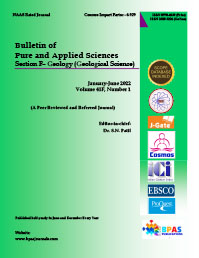Rhenium in the Earth's Crust: A Comprehensive Review of Mineralogy, Geochemistry and Economic Significance
DOI:
https://doi.org/10.48165/bpas.2023.42F.2.4Keywords:
Rhenium, Geochemistry, Molybdenite, Chalcopyrite, Economic ImplicationsAbstract
Rhenium, a unique and valuable metal with exceptional properties which is vital in various industrial applications, primarily found in conjunction with minerals like molybdenite and chalcopyrite, predominantly in western countries. Despite its rarity, understanding its geological distribution, geochemical characteristics, atomic structure, and behavior is essential. This paper provides a concise overview of the geological and geographical occurrences of rhenium, shedding light on its formation within both igneous and sedimentary environments. Additionally, it examines its economic significance, emphasizing its critical role in industries like aerospace, electronics, and petrochemicals due to its high-temperature resistance, corrosion resistance, and electrical conductivity enhancement. This comprehensive exploration highlights the importance of rhenium as a byproduct of mining, contributing significantly to technological advancements and innovation across various sectors.
Downloads
References
Akintomide, O. A., Adebayo, S., Horn, J. D., Kelly, R. P., and Johannesson, K. H., (2021). Geochemistry of the redox-sensitive trace elements molybdenum, tungsten, and rhenium in the euxinic porewaters and bottom sediments of the Pettaquamscutt River estuary, Rhode Island. Chemical Geology, 584, 120499. doi: 10.1016/j.chemgeo.2021.120499.
Bhattacharjee, S., Ghosh, S., and Sengupta, D., (2018). Characterization of copper molybdenum mineralization in parts of Singhbhum Shear Zone, India. Journal of Earth System Science, 127(5), 66.
Castillo, A., Higueras, P., and Oyarzún, J., (2018). The rhenium potential in copper deposits: A discussion based on a bibliographic review. Minerals, 8(4), 155.
Guo, X., Zhou, T., Wang, F., Fan, Y., Fu, P. and Kong, F., (2023). Distribution of Co, Se, Cd, In, Re and other critical metals in sulfide ores from a porphyry-skarn system: A case study of Chengmenshan Cu deposit, Jiangxi, China. Ore Geology Reviews, 158, 105520. doi: 10.1016/j.oregeorev.2023.105520.
Gupta, N. M., (2007). Rhenium Production and Applications: An Overview. Platinum Metals Rev., 51(3), 129–139.
Hagni, R. D., Koenig, A. E., Foley, N. K. and Pearson, D. W., (2017). Rhenium and osmium contents of molybdenite in porphyry Cu-Mo-Au systems: Genetic implications for ore-forming processes. Economic Geology, 112(5), 1051-1064.
Hattendorf, B. and Günther, D., (2003). Strategies for method development for an inductively coupled plasma mass spectrometer with a bandpass reaction cell: Approaches with different reaction gases for the determination of selenium. Spectrochimica Acta Part B: Atomic Spectroscopy, 58(1), 1-13.
Kesieme, U., Chrysanthou, A. andCatulli, M., (2019). Assessment of supply interruption of rhenium, recycling, processing sources and technologies. International Journal of Refractory Metals and Hard Materials, 82, 150-158.
Kesler, S. E., Wilkinson, B. H. and Kesler, S. E., (2005). Rhenium in molybdenite: A new geochemical tool for molybdenum mineralization. Economic Geology, 100(5), 1147-1156.
Li, Y., (2014). Comparative geochemistry of rhenium in oxidized arc magmas and MORB and rhenium partitioning during magmatic differentiation. Chemical Geology, 386, 101-
Mungall, J. E. and Brenan, J. M., (2014). Partitioning of Platinum-Group Elements and Re–Os Isotope Systematics between Sulfide and Silicate Melts in a Sulfide Saturated Magma Chamber. Geochimica et Cosmochimica Acta, 141, 170-194.
Naldrett, A., (1999). World-class Ni-Cu-PGE deposits: key factors in their genesis. Mineral Deposita, 34, 227–240.
Nebeker, N. and Hiskey, J. B., (2012). Recovery of rhenium from copper leach solution by ion exchange. Hydrometallurgy, 125-126, 64-68.
Peucker-Ehrenbrink, B., and Ravizza, G., (1995). Rhenium and osmium contents and osmium isotope ratios in marine sediments and their use as paleoceanographic tracers. Geochimica et Cosmochimica Acta, 59(19), 3959-3970.
Ravizza, G., andTurekian, K. K., (1989). Rhenium and osmium in seawater: A case study in the Sargasso Sea. Geochimica et Cosmochimica Acta, 53(2), 475-482.
Sillitoe, R. H. (2003). Iron oxide-copper-gold deposits: An Andean view. Mineralium Deposita, 38(7), 787-812.
Sillitoe, R. H., (2010). Porphyry copper systems. Economic Geology, 105(1), 3-41. 18. Stein, H. J., Markey, R. J., and Morgan, J. W.,
(1998). The distribution of Re between molybdenite and coexisting fluids: Constraints from natural samples and experiments. Geochimica et Cosmochimica Acta, 62(2), 275-285.
Takahashi, Y., Uruga, T., Suzuki, K., Tanida, H., Terada, Y., and Hattori, K. H., (2007). An atomic level study of rhenium and radiogenic osmium in molybdenite. Geochimica et Cosmochimica Acta, 71(21), 5180-5190.
United State Geological Survey, (2021). Mineral Commodity Summaries 2021. U.S. Geological Survey.
Werner, T. T., Mudd, G. M., Jowitt, S. M., and Huston, D., (2023). Rhenium mineral resources: A global assessment. Resources Policy, 82, 103441.
Zhao, Hong; Huang, Fan; Zhong, Shihua; Li, Chao; Feng, Chengyou; Hu, Zhaochu., (2023). The Wuliping Ion-Adsorption Deposit, Guizhou Province, South China: A New Type of Rhenium (Re) Deposit. Ore Geology Reviews, 160,105615.
Downloads
Published
Issue
Section
License

This work is licensed under a Creative Commons Attribution-NonCommercial-NoDerivatives 4.0 International License.



